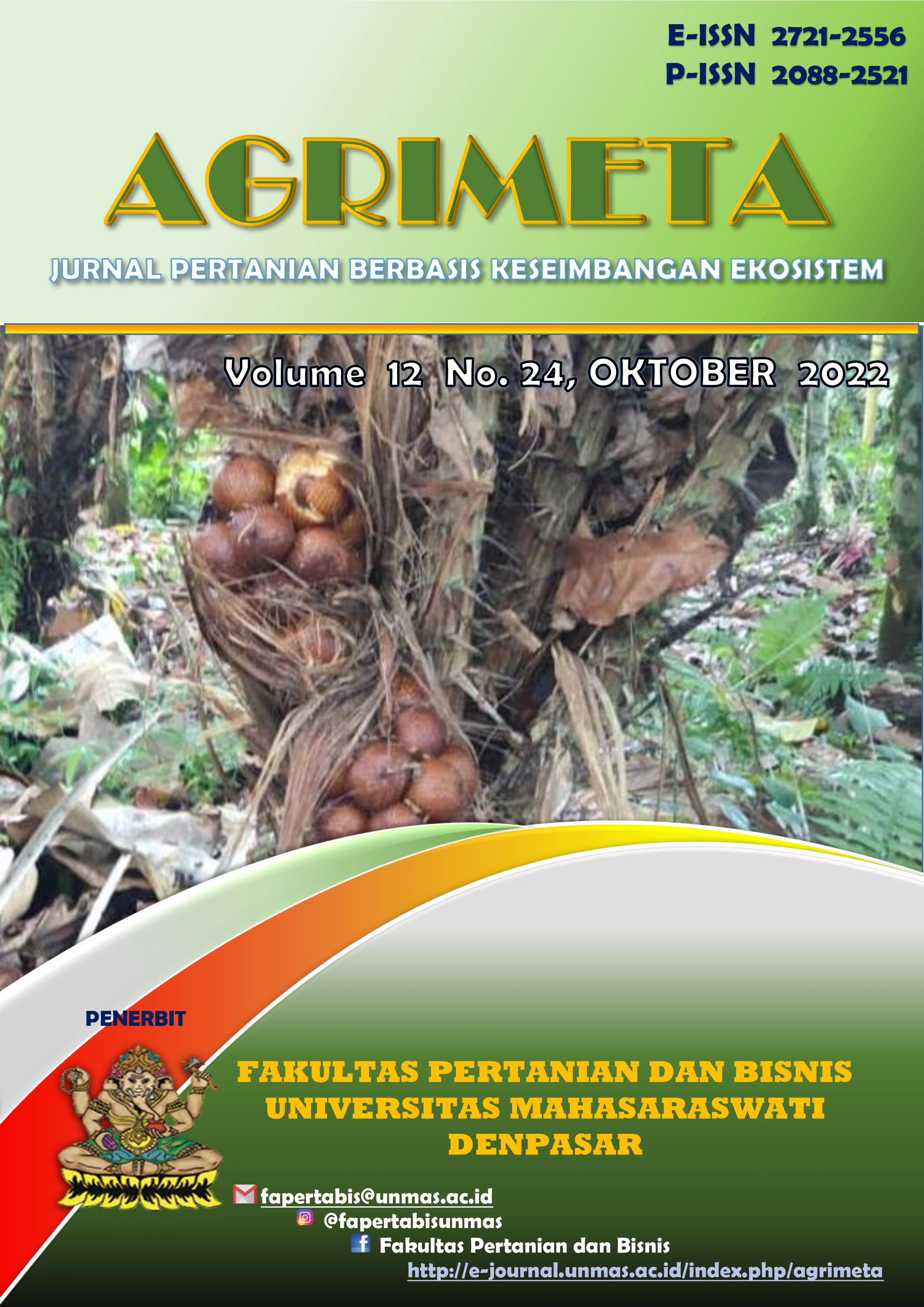IDENTIFIKASI KUALITAS DAN BOBOT MASA SIMPAN BEBERAPA JENIS BUAH SALAK BALI (Salacca Zalacca Var. Amboinensis)
Keywords:
Quality, shelf life weight, salak fruitAbstract
Bali salak fruit is one of the preferred fruit plants and has good prospects for cultivation. and the production of salak fruit is very large. This study, entitled "Identification of the quality and shelf-life of several types of salak Bali (Salacca zalacca var. Amboenensis)" was carried out at the center of salak development in Sibetan Village, Karangasem Regency, Bali. This study aimed to identify the quality and shelf life of several types of Balinese salak in Sibetan Karangasem. And get the type of salak bali which has the best quality and weight of the shelf life of salak fruit. This study used randomized block design (RAK) using 8 treatments which were repeated 4 times so as to get 32 treatments, the results of the identification of the quality and weight of the shelf life of salak fruit gave a very significant effect on the number of bunches of fruit, fruit weight, shelf life weight, and had an effect on significantly on the weight of the bunch, the thickness of the flesh and the level of acidity in the medium, the low level of TPT (total dissolved solids), and the high level of vitamin C. And the salak fruit that has the best quality and shelf-life weight is sugar salak with a mass of 48.75 g, and the quality of salak acid content of granulated sugar with a value of 18.3 pH, TPT (total dissolved solids) with a value of 0.34, and vitamin C content with a value of 199.61 mg
Downloads
References
Ashari, S. 1995. Hortikultura Aspek dan Budidaya. Jakarta : UI.Press , h 4-85.
Bank Indonesia 2004. Pola pembiayaan usaha kecil (PPUK). Budidaya salak unggul. Bank Indonesia. pp. 35.
Pantastico, Er. B. 1989. Postharvest Physiology, Handling and Utilization of Tropical and Subtropical Fruit and Vegetables.The Avi Publishing Company Inc. Westport, Connecticut. 906 Halaman.
Pantastico, E.R.B. 1997. Fisiologi Pasca Panen. Penanganan dan Pemanfaatan Buahan dan Sayur-Sayuran Tropika dan Subtropika.
Rai, I. N., C.G.A. Semarajaya, W. Wiraatmaja. 2010. A Study on the Flowering Phenophysiology ofGula Pasir Snake Fruit to Prevent Failure of Fruit-set. J. Hort. 20(3):216-222.
Rahmawati, M. 2010. Kajian Sifat Kimia Salak Pondoh (Salacca edulis Reinw) Dengan Pelapisan Khitosan Selama Penyimpanan Untuk Mempreduksi Masa Simpannya.Jurnal Teknologi Pertanian 6 (1). Halaman 20-24.
Sumantra, K. Sumeru Ashari, T. Wardiyati, Agus Suryanto, 2011. Hasil dan mutu buah salak gulapasir pada berbagai ketinggian berbeda di daerah pengembangan baru di Bali. Prosiding Seminar Nasional Perhimpunan Hortikultura.Lembang 23-24 Nopember 2011.
Vina Herviana Manurung, G. S. S. Djarkasi, T, M, Langi, dan L, E, Lalujan.(2013). Analisis Sifat Fisik Dan Kimia Buah Salak Pangu (Salacca zalacca) Dengan Pelilinan Selama Penyimpa nan.
Wijana, G. 1990. Telaah sifat-sifat buah salak Gulapasir sebagai dasar penggunaannya. Fakultas Pascasarjana, Institut Pertanian Bogor. pp. 163






